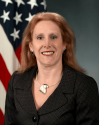Reflections on Receiving the ISTSS Public Advocacy Award
Jacqueline Garrick, LCSW-C
March 28, 2013
 The honor of being ISTSS Public Advocate inspires reflection. As a member since 1989, I have seen a multitude of changes in beliefs, attitudes and support offered to trauma survivors. The field has come a long way because of the synergy created by researchers, practitioners, advocates and the survivor’s themselves–who have at times been their own greatest voice. In my own observation, it was the Vietnam Veteran generation that spoke out when care was not meeting their needs. They demanded more from the institutions designed to assist them and those systems were forced to respond. Practitioners then asked for better evidence and researchers designed better studies. Advocates testified to these results and institutions changed rules, regulations and laws to move the standard of care forward.
The honor of being ISTSS Public Advocate inspires reflection. As a member since 1989, I have seen a multitude of changes in beliefs, attitudes and support offered to trauma survivors. The field has come a long way because of the synergy created by researchers, practitioners, advocates and the survivor’s themselves–who have at times been their own greatest voice. In my own observation, it was the Vietnam Veteran generation that spoke out when care was not meeting their needs. They demanded more from the institutions designed to assist them and those systems were forced to respond. Practitioners then asked for better evidence and researchers designed better studies. Advocates testified to these results and institutions changed rules, regulations and laws to move the standard of care forward.
Yet, access to care can sometimes be complicated by wait lists, treatment costs, quality assurance and untenable results. Those diagnosed with posttraumatic stress disorder (PTSD) might also suffer from substance abuse, suicidal ideation, traumatic brain injury or other physical disability making the course of care more complicated. Add to this the social stressors of our modern times, an economic crisis and political dismay, and the help offered by the professional caregiver seems diminutive in comparison. So as an advocate, I am left to wonder what our role is as Society members in extending beyond our scope of care and evidence-based practices into building a world where hope reigns and resiliency abounds.
At the 2012 ISTSS Annual Meeting, I heard something that I hadn’t heard in a long time– inspiration and empowerment of survivors. Dr. Vikram Patel presented a keynote address on his treatment of mental illness with a “task-sharing” approach, in which ordinary people train to offer peer support to those needing care. He spoke of the shortage of trained professionals in India and about how women there were being trained to offer care and support to new mothers. As a result, the peer supporters who were task sharing and extending the scope of work of a professional community were seeing healthier mothers and babies.
This grassroots approach has implications beyond what might seem to be a solution only for an impoverished society, but also in the western world where the best of care is available, but is not always the most practical. For example, in working with members of the military, reluctance to seek care is predicated on mental health misperceptions, concerns over confidentiality, impacts to career, or rural and remote locations, including deployments and combat. Furthermore, although sometimes eligible, family members are often uninformed about resources, fearful of repercussions, and isolated from information (even if the best care is a block away). So, Service members and their families turn to each other and social media for support and information. Thus, hope and resilience are born and nurtured in communities – not in clinics. For these trauma survivors, the path to recovery is inherent in their own network.
We need a network at ISTSS as well. When researchers just talk to researchers about evidence--based best practices, the practitioners do not learn and when the survivors themselves are not involved in the process, we might miss the opportunity to meet their real needs, which extend beyond the clinic walls. Posttraumatic growth occurs not just with the help of professionals, but with the support of a community. We must recognize that there is a wellness continuum – beginning with resistance, fostering resilience, practicing recovery and leading to reintegration.
ISTSS does an excellent job of emphasizing recovery. Evidence-based best practices for clinical care are the mainstay for what most members do, but we do not practice nor do survivors live in that vacuum. Our expertise in trauma must embrace a public health model that communicates positive messages of survivorship, that seeking help is a sign of strength and that mental health treatment works. But, this cannot be accomplished by professionals only. It takes a partnership with non-professionals (volunteers) and para-professionals (peer counselors) who are community-based and more accessible to survivors than are the professional providers who live in the one-hour a week paradigm. Embracing this continuum and the network it envelops extends our ability to case manage and offer support that shifts the loci of care from the clinic to the community. This not only helps survivor recovery, but reintegrates into a life of quality.